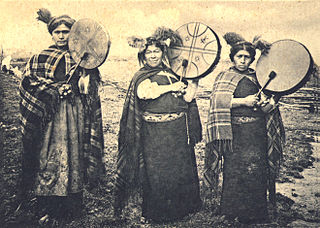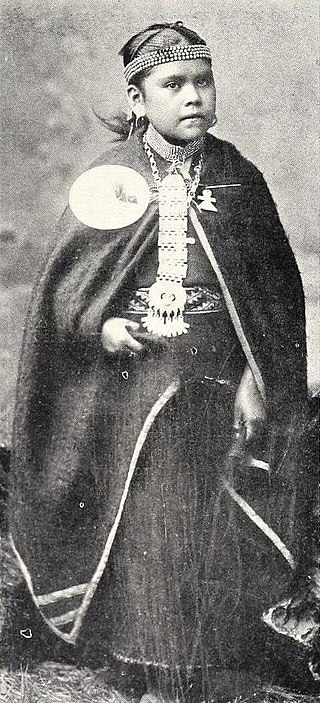Related Research Articles

Mapuche ; from mapu 'land' and dungun 'speak, speech') is an Araucanian language related to Huilliche spoken in south-central Chile and west-central Argentina by the Mapuche people. It is also spelled Mapuzugun and Mapudungu. It was formerly known as Araucanian, the name given to the Mapuche by the Spaniards; the Mapuche avoid it as a remnant of Spanish colonialism.

The Mapuche is a group of native indigenous inhabitants of south-central Chile and southwestern Argentina, including parts of Patagonia. The collective term refers to a wide-ranging ethnicity composed of various groups who share a common social, religious, and economic structure, as well as a common linguistic heritage as Mapudungun speakers. Their homelands once extended from Aconcagua Valley to the Chiloé Archipelago and later spread eastward to Puelmapu, a land comprising part of the Argentine pampa and Patagonia. Today the collective group makes up over 80% of the indigenous peoples in Chile and about 9% of the total Chilean population. The Mapuche are concentrated in the Araucanía region. Many have migrated from rural areas to the cities of Santiago and Buenos Aires for economic opportunities.

Osorno Province is one of the four provinces in the southern Chilean region of Los Lagos (X). The province has an area of 9,223.7 km2 (3,561 sq mi) and a population of 221,496 distributed across seven communes. The provincial capital is the city of Osorno.
Kalku or Calcu, in Mapuche mythology, is a sorcerer or witch who works with black magic and negative powers or forces. The essentially benevolent shamans are more often referred to as machi, to avoid confusion with the malevolent kalku. Its origins are in Mapuche tradition.

The Tehuelche people, also called the Aónikenk, are an indigenous people from eastern Patagonia in South America. In the 18th and 19th centuries the Tehuelche were influenced by Mapuche people, and many adopted a horseriding lifestyle. Once a nomadic people, the lands of the Tehuelche were colonized in the 19th century by Argentina and Chile, gradually disrupting their traditional economies. The establishment of large sheep farming estates in Patagonia was particularly detrimental to the Tehuelche. Contact with outsiders also brought in infectious diseases ushering deadly epidemics among Tehuelche tribes. Most existing members of the group currently reside in cities and towns of Argentine Patagonia.

The religion of the indigenous Mapuche people of south-central Chile and southwestern Argentina is an extensive and ancient belief system. Legends and myths are common to the various groups that make up the Mapuche people. These myths tell of the creation of the world and the various deities and spirits that reside in it.
The legend of Trentren Vilu and Caicai Vilu (Kaikai) is a Mapuche flood myth that tells the story of a fierce battle between two mythical snakes, Trentren Vilu and Caicai Vilu. It explains how the Chilóe archipelago and mountains of southern Chile came to have its unique geography.
Ten Ten-Vilu or Trentren-Vilu is the Mapuche god of Earth and Fertility ; he has a generous spirit and is the protector of all life on Earth, and the flora and fauna and according to some Mapuche myths. This snake was a central figure in the Origin Of The Chiloean Archipelago. In Mapuche mythology, Ten Ten-Vilu is son of Antü.

Coi Coi-Vilu or Caicai-Vilu/Cai Cai Vilu is the Mapuche god of water and, according to Mapuche myths, supreme ruler of the sea and of all sea-dwellers. This snake was a central figure in the Origin Of The Chiloean Archipelago. In Mapuche mythology, Coi Coi-Vilu is son of Peripillan.
The Pillan is a powerful and respected male spirit in Mapuche mythology.
The wekufe, also known as huecufe, wekufü, watuku, huecufu, huecubo, huecubu, huecuvu, huecuve, huecovoe, giiecubu, güecubo, güecugu, uecuvu, güecufu; is an important type of harmful spirit or demon in Mapuche mythology. The word wekufe comes from the Mapudungun word wekufü meaning "demon, outside being".

Coordinadora Arauco-Malleco (CAM) is a radical, militant indigenous organization engaged in political violence in pursuit of attaining an autonomous Mapuche state in the territory they describe as Wallmapu.
The Mapuche conflict involves indigenous Mapuche communities, also known as the Araucanians, located in Araucanía and nearby regions of Chile and Argentina. It is often referred to as a conflict between the Mapuche and the Chilean government or state, despite the fact that there have been a variety of other actors participating in the conflict such as the Spanish Empire as well as corporations such as big forestry companies and their contractors. In the past decade of the conflict, Chilean police and some non-indigenous landowners have been confronted by militant Mapuche organizations and local Mapuche communities in the context of the conflict. Some scholars argue the conflict is an indigenous self-determination conflict, others like Francisco Huenchumilla see it as the expression of a wider political conflict that affects all of Chile given the existence of other indigenous groups.
Antu is the name given to the principal Pillan spirit in Mapuche mythology. Antü is the most powerful Pillán, who governs the other Pillans. In Mapuche mythology, Antu represents the Sun, as well as light, wisdom and spirit, and is opposite to darkness and the physical world, and is married to Kueyen, a Wangulén spirit that represents the moon.
Kueyen or kuyen is the name given to the moon in Mapuche mythology. She is the principal wangulen spirit. Kueyen governs the others wangulen spirits. Kueyen is married Antu.
Mapuche flag is each of the flags used as an emblem and symbol of the Mapuche Nation and the Mapuche communities and organizations in Chile and Argentina. There are several different flags representing the Mapuche communities and territories.

Mapuche silverwork is one of the best known aspects of Mapuche material culture. The adornments have been subject to changes in fashion but some designs have resisted change.

Weichán Auka Mapu (WAM) is a Mapuche armed and revolutionary organization that operates mainly in southern Chile, being a supporter of armed struggle through arson attacks, sabotage actions and clashes with firearms against police officers, in order to achieve full autonomy for the Mapuche people.
References
- Alberto Trivero (1999), Trentrenfilú, Proyecto de Documentación Ñuke Mapu. (in Spanish)
- María Ester Grebe (4 February 2005), Los espíritus de la naturaleza en la religiosidad Mapuche, Mapuexpress Informativo Mapuche.(in Spanish)